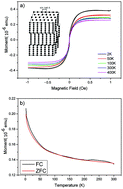Room temperature p-orbital magnetism in carbon chains and the role of group IV, V, VI, and VII dopants
Abstract
The study of magnetism without the involvement of transition metals or rare earth ions is considered the key to the fabrication of next generation spintronic devices. Several recent reports claim that optimizing the occupation number of the mixed p-orbitals is the correct way to reinforce p-orbital magnetism in bulk crystals. We provide experimental evidence that the kinked monoatomic carbon chains, the so-called linear-chained carbon, generate intrinsic ferromagnetism even above room temperature. According to our ab initio calculations, unconventional magnetism has its origin in the p-shells. In contrast, the linear monoatomic carbon chains are non-magnetic. Although the optimized differential spin density of states at the Fermi level (SDOS) of the kinked carbon chains is higher than that of bulk Fe, the magnetic moment is as low as 0.3μB. In order to enhance the magnetic response, we decided to tune the p-orbital magnetism by adding dopants from groups IV to VII of the periodic table. We observed that the strength of the p-orbital magnetism and the sign of the exchange interaction depend not only on the kink angle, but also on the concentration of lone pair electrons, free radical electrons, lateral chain spacing, internal electric dipole, dative covalent bonds and the Bohr radius of the dopants. Surprisingly, the V and VII-doped carbon chains show a strong non-zero SDOS, which has its origin in the p-shells. The VII-doped carbon chains give the SDOS of the opposite sign. Our best system, the arsenic-doped carbon chain, exhibits a strong local magnetic moment of 1.5μB, which is comparable to that of the bulk Fe of 2.2μB, with the mean exchange–correlation energy reaching a 63% ratio relative to that of the bulk Fe.



 Please wait while we load your content...
Please wait while we load your content...